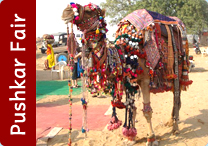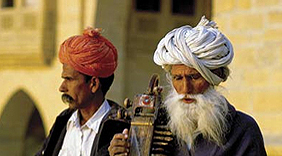
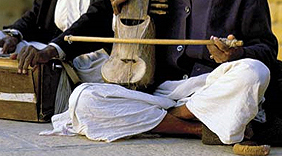

Custom Made Tour
Feel free to let us know if you are looking for customize tour program as all the tour itinerary is sample it can be modify according to your requirements.
Home - Attractions of Rajasthan
Attractions of Rajasthan
Meherangarh Fort, Jodhpur
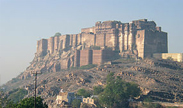
Past of Mehrangarh fort in Rajasthan, India has no mention of any seizure. The invincible fortifications are six meters thick. Some of the walls still bear cannon marks they had once withstood. Today this magnificent Jodhpur fort is a living testimony that recounts the chronicles and legends of Jodhpur's rich past.
Jain Temple - Ranakpur, Udaipur
The Ranakpur Jain Temple was built during the reign of the liberal and gifted Rajput monarch Rana Kumbha in the 15th century, in the AD 1439. The basement is of 48,000 sq. feet area that covers the whole complex. There are four subsidiary shrines, twenty-four pillared halls and domes supported by over four hundred columns. The total number of columns is 1,444 all of which are intricately carved with no two being alike. The artistically carved nymphs playing the flute in various dance postures at a height of 45 feet are an interesting sight. In the assembly hall, there are two big bells weighing 108 kg whose sound echoes in the entire complex. The main temple is a Chaumukh or a four-faced temple dedicated to Adinath.Kumbhalgarh Fort, Udaipur
Located 64 kms north of Udaipur in the wilderness, Kumbhalgarh is the second most important citadel after Chittorgarh in the Mewar region. Cradled in the Aravali Ranges the fort was built in the 15th century by Rana Kumbha. Because of its inaccessibility and hostile topography the fort had remained un-conquered. It also served the rulers of Mewar as a refuge in times of strife. The fort also served as refuge to the baby king Udai of Mewar. It is also of sentimental significance as it is the birthplace of Mewar's legendary King Maharana Partap. The fort is self-contained and has within its amalgam almost everything to withstand a long siege.The fort fell only once that too to the combined armies of Mughal and of Amber for scarcity of drinking water. Many magnificent palaces an array of temples built by the Mauryas of which the most picturesque place is the Badal Mahal or the palace of the clouds. The fort also offers a superb birds view of the surroundings. The fort's thick wall stretches some 36 kms and is wide enough to take eight horses abreast. Maharana Fateh Singh renovated the fort in the 19th century. The fort's large compound has very interesting ruins and the walk around it can be very rewarding.
Jaisalmer Fortress, Jaisalmer
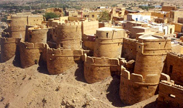
The pilgrims follow a 400-mile-long road from Jaipur. They drive through fierce desert winds that blow all the way to Delhi. In summer, they endure 105-degree heat. They come to an area where, for the past 2,000 years, water has been in short supply.
They come because there is no other place on earth like Jaisalmer.
Elefantastic, Jaipur
Elefantastic is an initiative begun in 2012 to understand and promote the well being of the few surviving giants of the planet. We promote Eco-touristic values and look out for the ones who would want to put their hand forward for the trunk. Before starting this program Rahul, the founder of Elefantastic, himself worked as an elephant-rider for 9 years. During this time he met a lot of tourists who talked about how they would like to see more of these animals than just the usual rides. He also found that alot of foreigners have the idea that elephants are treated very poorly in India, and wanted to show them that this is not always the case.Anokhi Museum of Hand Printing, Jaipur
Anokhi Museum of Hand Printing is a charitable foundation that works with an objective of preserving the traditional customs and works of artisans living in Jaipur. This foundation provides employment opportunities to several artisans by nurturing their talent and skills. It also aims at reviving the age old tradition of hand block printing, with a special focus on the traditional hand printing methods and techniques.Cave Painitngs, Bundi
Bundi is, much acclaimed for its beautiful rock paintings and murals. To witness its history and perspective is just like stepping back into the ancient time. Bundi has one of the largest rock painting sites in India. Rock paintings are a particular form of paintings done on the walls and ceilings of the cave shelter of ancient man. These paintings were the reflections of their social, cultural, religious and economic life. The rock paintings depict the continuity of human evolution. It also unveils the hunting scenes, daily life of the Mesolithic period, human figure and dancing postures along with Bison, Deer and Tiger.The paintings are estimated to be 15000 years old bearing ample proof of the fact that the Hadoti region sustained early man. It was once the shelter for people who followed Buddhism culture. At The Hadoti Palace we can organise a special tour to these rock painting sites which is a once in a life time experience.
Ranthambore Tiger Reserve, Sawai Madhopur

The Ranthambhore National Park at the junction of the Aravalis and the Vindhyas, is a unique juxtaposition of natural and historical richness, standing out conspicuously in the vast, arid and denuded tract of eastern Rajasthan,barely 14 kilometer from the town, Sawai Madhopur.
Sam Sand Dunes, Jaisalmer
There is no point coming to the Thar Desert if you don't go for the Desert Safari. That is why Sam sand dunes are becoming the major attraction in Jaisalmer. This is the closest place from where you can loose yourself in 'the Great Thar Desert'. Sam has a truly magnificent stretch of sweeping dunes, with sparse or no vegetation. The best way to get here, of course, is on camelback.Join a camel caravan at Jaisalmer on your Rajasthan tours and ride along the breathtaking crests and troughs. Enjoy the romance of solitude as your camel takes you deep in the hearts of the Thar Desert. Put yourself in the camp and experience the sun setting behind the horizon. Organize a bonfire with the fellow tourists in the night and enjoy the rustic and earthy music and dance of Rajasthan.


